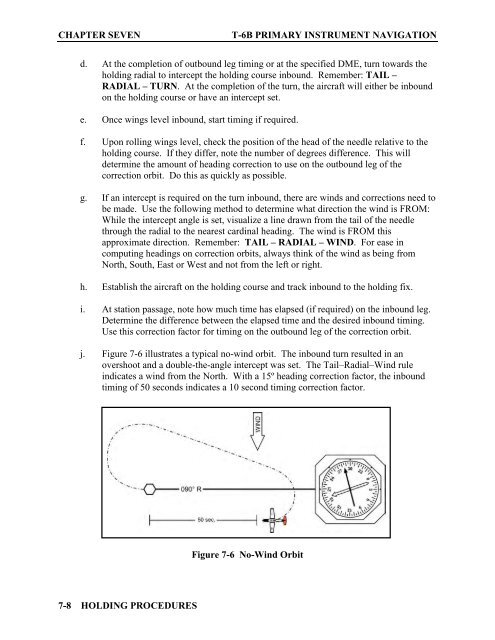Flight Training Instruction - Cnatra - U.S. Navy
Flight Training Instruction - Cnatra - U.S. Navy
Flight Training Instruction - Cnatra - U.S. Navy
Create successful ePaper yourself
Turn your PDF publications into a flip-book with our unique Google optimized e-Paper software.
CHAPTER SEVEN T-6B PRIMARY INSTRUMENT NAVIGATION<br />
d. At the completion of outbound leg timing or at the specified DME, turn towards the<br />
holding radial to intercept the holding course inbound. Remember: TAIL –<br />
RADIAL – TURN. At the completion of the turn, the aircraft will either be inbound<br />
on the holding course or have an intercept set.<br />
e. Once wings level inbound, start timing if required.<br />
f. Upon rolling wings level, check the position of the head of the needle relative to the<br />
holding course. If they differ, note the number of degrees difference. This will<br />
determine the amount of heading correction to use on the outbound leg of the<br />
correction orbit. Do this as quickly as possible.<br />
g. If an intercept is required on the turn inbound, there are winds and corrections need to<br />
be made. Use the following method to determine what direction the wind is FROM:<br />
While the intercept angle is set, visualize a line drawn from the tail of the needle<br />
through the radial to the nearest cardinal heading. The wind is FROM this<br />
approximate direction. Remember: TAIL – RADIAL – WIND. For ease in<br />
computing headings on correction orbits, always think of the wind as being from<br />
North, South, East or West and not from the left or right.<br />
h. Establish the aircraft on the holding course and track inbound to the holding fix.<br />
i. At station passage, note how much time has elapsed (if required) on the inbound leg.<br />
Determine the difference between the elapsed time and the desired inbound timing.<br />
Use this correction factor for timing on the outbound leg of the correction orbit.<br />
j. Figure 7-6 illustrates a typical no-wind orbit. The inbound turn resulted in an<br />
overshoot and a double-the-angle intercept was set. The Tail–Radial–Wind rule<br />
indicates a wind from the North. With a 15º heading correction factor, the inbound<br />
timing of 50 seconds indicates a 10 second timing correction factor.<br />
7-8 HOLDING PROCEDURES<br />
Figure 7-6 No-Wind Orbit
















